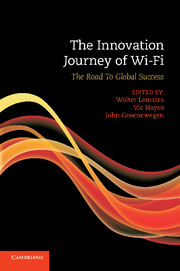Book contents
- Frontmatter
- Contents
- Figures
- Tables
- Contributors
- Preface
- Introduction
- 1 The case and the theoretical framework
- Part 1 The Wi-Fi Journey
- Part 2 The Wi-Fi Journey in Perspective
- 7 Wi-Fi in developing countries: catalyst for network extension and telecom reform
- 8 The Dutch connection to US-based NCR, AT&T, Lucent Technologies and Agere Systems
- 9 Wi-Fi as community-based innovation
- 10 The governance of radio spectrum: licence-exempt devices
- 11 Exploring the future of Wi-Fi
- 12 Reflections and implications for policy and strategy formation
- Part 3 Annexes
- Index
- References
12 - Reflections and implications for policy and strategy formation
Published online by Cambridge University Press: 05 June 2012
- Frontmatter
- Contents
- Figures
- Tables
- Contributors
- Preface
- Introduction
- 1 The case and the theoretical framework
- Part 1 The Wi-Fi Journey
- Part 2 The Wi-Fi Journey in Perspective
- 7 Wi-Fi in developing countries: catalyst for network extension and telecom reform
- 8 The Dutch connection to US-based NCR, AT&T, Lucent Technologies and Agere Systems
- 9 Wi-Fi as community-based innovation
- 10 The governance of radio spectrum: licence-exempt devices
- 11 Exploring the future of Wi-Fi
- 12 Reflections and implications for policy and strategy formation
- Part 3 Annexes
- Index
- References
Summary
Summary
The present-day success of Wi-Fi can be traced back to a change in US government policy intended to simplify the rules for the use of radio frequency spectrum and to the idea to allow the public use of spread-spectrum technology. The 1985 decision of the Federal Communications Commission to allow spread-spectrum-based radio communication in the three bands designated for industrial, scientific and medical applications encouraged communication firms to innovate and develop new short-range data communication products. NCR recognised the need to leverage existing standardised communication protocols and became the driving force in the development and adoption of an open wireless LAN standard, IEEE 802.11, as were its corporate successors AT&T, Lucent Technologies and Agere Systems.
Thanks to contractual agreements with Apple and subsequent cooperation with Microsoft, the product reached the mass market. In the process the product moved from its intended use, as a WLAN in the corporate environment, to application in the home. Subsequently the home and business use was extended further through the provision of internet access services at ‘hotspots’ and ‘hotzones’, and more recently through city-wide Wi-Fi networking. The low-threshold technology also resulted in networks being created by communities of volunteers, in developed as well as developing countries, to provide alternative network access, filling a void left by the incumbent telecommunications operators. The case history of Wi-Fi is an illustration of how innovation can be triggered by policy, developed by industry and shaped by its users.
- Type
- Chapter
- Information
- The Innovation Journey of Wi-FiThe Road to Global Success, pp. 367 - 378Publisher: Cambridge University PressPrint publication year: 2010



